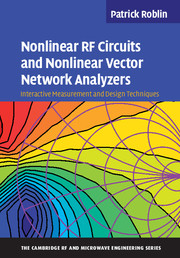 Nonlinear RF Circuits and Nonlinear Vector Network Analyzers
Nonlinear RF Circuits and Nonlinear Vector Network Analyzers Book contents
- Frontmatter
- Contents
- Preface
- Dedication
- Acknowledgments
- 1 Wireless signals
- 2 Large-signal vector measurement techniques with NVNAs
- 3 Device modeling and verification with NVNA measurements
- 4 Characterization and modeling of memory effects in RF power transistors
- 5 Interactive loadline-based design of RF power amplifiers
- 6 Behavioral modeling
- 7 Kurokawa theory of oscillator design and phase-noise theory
- 8 Design, modeling, and linearization of mixers, modulators, and demodulators
- 9 Linearization of RF power amplifiers with memory
- Index
- References
5 - Interactive loadline-based design of RF power amplifiers
Published online by Cambridge University Press: 05 July 2011
- Frontmatter
- Contents
- Preface
- Dedication
- Acknowledgments
- 1 Wireless signals
- 2 Large-signal vector measurement techniques with NVNAs
- 3 Device modeling and verification with NVNA measurements
- 4 Characterization and modeling of memory effects in RF power transistors
- 5 Interactive loadline-based design of RF power amplifiers
- 6 Behavioral modeling
- 7 Kurokawa theory of oscillator design and phase-noise theory
- 8 Design, modeling, and linearization of mixers, modulators, and demodulators
- 9 Linearization of RF power amplifiers with memory
- Index
- References
Summary
The design of high-efficiency RF power amplifiers is of critical importance for wireless mobile devices and basestations. Design techniques that rely on circuit simulators are limited by the accuracy of the nonlinear large-signal models and by device package parasitics. Designing amplifiers using load-pull measurements is an alternative approach that bypasses the need for accurate device models. This chapter is concerned with the NVNA-assisted load-pull design of RF power amplifiers.
In this chapter, we will first compare the ideal and measured current and voltage waveforms, dynamic loadlines, and dynamic transfer characteristics for transistors operating in various fundamental amplifier classes (A–F). A multi-harmonic real-time active load-pull (RTALP) technique for the interactive design of the output-matching network will also be introduced and applied to the optimization of the amplifier power efficiency. The aim is to demonstrate how NVNAs can facilitate the design of power amplifiers by providing designers with greater insights into the actual mode of operation of the active devices.
Review of power amplifiers of various classes (A–F)
Class-A amplifiers provide a tradeoff between linearity and power efficiency. Specifically, they offer an excellent linearity at the price of poor efficiency because the device is on even when no RF signal is applied. The conceptual class-A circuit is shown in Figure 5.1 (a). An RFC is used to provide the supply voltage VDD to the transistor while blocking the RF from the DC supply circuit.
- Type
- Chapter
- Information
- Nonlinear RF Circuits and Nonlinear Vector Network AnalyzersInteractive Measurement and Design Techniques, pp. 124 - 159Publisher: Cambridge University PressPrint publication year: 2011


